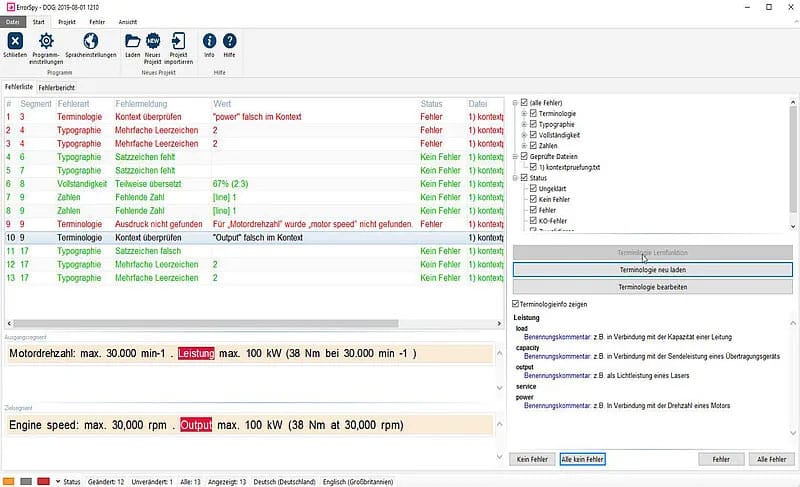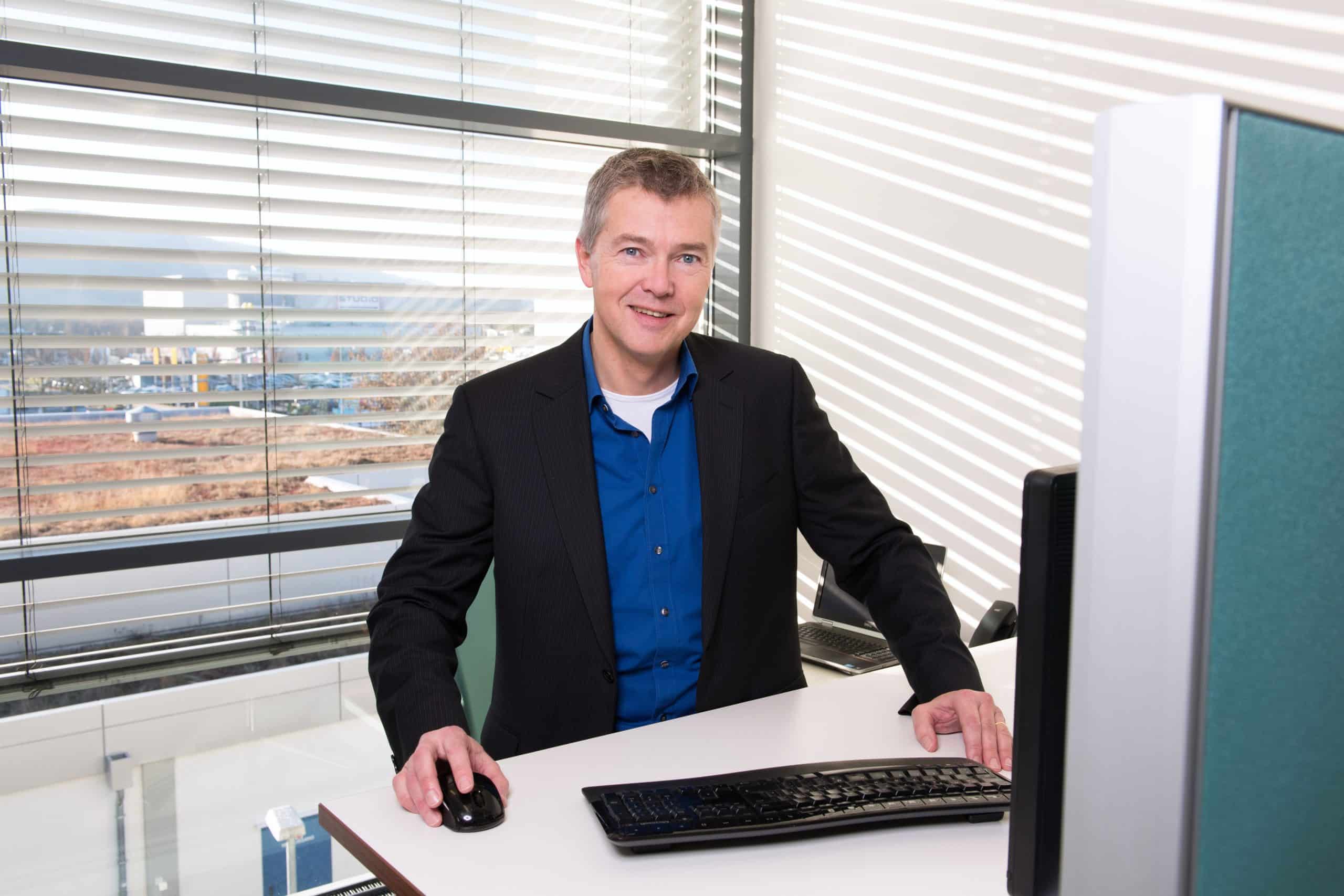
Translation quality according to DIN EN ISO 17100
Translation agency with quality guarantee
- All translations are checked according to the dual control principle
- All specialized translators have proven qualifications
- Our quality assurance software ErrorSpy supports the revisers
Translation quality is no coincidence
Translation quality is our promise
Translation quality already played an important role in our strategy when D.O.G. was founded. What we considered a central challenge back then is now widespread reality. The production of texts and translations is taking on industrial proportions: Texts are modularized and stored in databases such as PIM systems or content management systems and reused and reassembled as needed. The same is true for translations, which are partly generated from the content of translation memory systems (also called translation memories or CAT tools). In addition, translations now also come from machine translation systems.
Thus, the information that the end user receives is often a patchwork of different sources, created at different times and with the help of different authors and translators. One of the biggest challenges in technical documentation is ensuring that all parties use consistent terminology.
Our quality assurance technologies
This led us to develop our ErrorSpy quality assurance software in 2003. At the time, it was the first commercial translation quality assurance software. Since then, we have been constantly developing ErrorSpy and adding new features to reliably detect and fix translation errors.
ErrorSpy quality assurance software


Translation into all languages
We translate into all languages
Do you need a translation? We will send you a quote within the shortest possible time. Send us your request with this quote form.
Our services for you
These aspects are part of ensuring translation quality
Linguistic aspects:
- Correct grammar and spelling.
- Adherence to terminology.
- Equivalence of terms in foreign languages.
- Adaptation to country-specific conventions, typography, correct sentence structure.
Technical and content aspects:
- Technical correctness of the translated content.
- Correctness of the numbers and number format.
- Text comprehension. Engineers, lawyers, physicians, programmers and other experts are available to us for this purpose.
Technical aspects:
- Links
- Special character encoding
- Text length
- Program version
Translation quality challenges
We have the necessary knowledge
Our concept for translation quality
We do not simply claim that our translations are perfect. We have developed a system for this, because translation quality is no coincidence. In over 20 years, we have built up and refined a pragmatic and efficient quality procedure that has proven its worth. You can benefit from it and rely on it:
- Our specialized translators have proven qualifications. They are not an anonymous mass of applicants who filled in a form at some point, but they have all been selected on the basis of their qualifications and are continuously checked. We were also able to prove this during the audits for ISO 17100.
- Sometimes passages in a text are ambiguous or difficult to understand without company knowledge ( proprietary technical terms, abbreviations,...). Our specialized translators do not just translate them blindly, but ask questions that our revisers answer themselves or after consulting with our clients.
- For regular clients, we always use the same translators who are familiar with the specific requirements of that client.
- Our project managers are linguists who are familiar with the special linguistic and technical requirements of translation production.
- We proofread all translations according to the dual control principle. Our revisers are experienced translators themselves.
- For our regular customers, we develop multilingual terminology and can thus guarantee the consistent use of your specialized terminology.
- In addition to the standard checks that apply to all translation projects, we perform additional individual quality assurance steps as needed, which we determine according to our clients' requirements.
- We use our quality assurance software ErrorSpy for support. ErrorSpy is in no way a substitute for quality assurance by the reviser. It relieves the reviser by automating the formal checks, thus giving him more time for content-related checks.
- We regularly check the quality of our translators and evaluate each translation. We discuss any deficiencies with our translators. In this way, we ensure that all the specialist translators we use meet our quality standards.
- We are certified to the ISO 17100standard and have developed procedures to ensure that all translations are of consistent D.O.G. quality. Whether in English, French, Spanish or Chinese or any other language!
This is how your orders are processed
Translation process of D.O.G. GmbH

You send us your texts

We prepare the files for translation

We extract the terminology

We translate
your texts

Revision
of the translation

Reformatting the translation

Final check in the formatted version

Translation evaluation

We update all databases
Translation quality assurance process

Another SEO headline
Lorem ipsum dolor sit amet, consetetursadipscingelitr, sed diam nonumy eirmod tempor.

Another SEO headline
Loremipsumdolor sit amet, consetetur sadipscing elitr, sed diam nonumy eirmod tempor.

Another SEO headline
Lorem ipsum dolor sit amet, consetetursadipscingelitr, sed diam nonumy eirmod tempor.

Another SEO headline
Loremipsumdolor sit amet, consetetur sadipscing elitr, sed diam nonumy eirmod tempor.
Translation quality is teamwork
Five tips on how you can contribute to a better translation quality.
Tip 1:
Give the translator enough time. A professional translator can translate about 2,000 words per day. Add time for revision and any technical tasks.
Tip 2:
Write texts that are suitable for translation. Avoid ambiguities, explain difficult terms or abbreviations. Write short sentences. Use your terminology consistently and use technical terms as precisely as possible instead of generic terms (not just valve, but gas control valve).
Tip 3:
Provide reference material: previous translations, drawings and pictures, technical articles or similar. Anything that helps the translator better understand the technical terms and content used.
Tip 4:
Include a terminology list, if available. The translator can then translate consistently with previous translations. This will improve the quality of the translation and of the translation memories.
Tip 5:
Name a contact person for technical questions.
FAQ
That is why we guarantee quality
The translators need to.
- have a university degree in translation OR
- have a college degree in another field and at least 2 years of professional experience as a translator OR
- have at least 5 years of professional experience as a translator,
- have expertise in the field of the text to be translated (subject matter expertise)
.
.
The revisers must
- have the same qualification as the translators AND
- check the translation against the source text for linguistic and content accuracy
.
.
The technical reviewers must
- be subject matter specialists.
The translations must be checked according to the dual control principle.
Most professional translators study three to five years at a college or university and have at least two years of professional experience before they start translating specialized texts for us. They learn not only languages, but also the culture of the languages in question, linguistic aspects, translation techniques, the technologies required, and much more. They also specialize in certain fields. As in any profession, a theoretical and practical foundation is important in order to do professional work.
The results of machine translation (MT) are impressive and in many situations it is a real alternative to human translation. Especially in combination with post-editing. Machines do not think and, due to their algorithms, sometimes make catastrophic mistakes that can have far-reaching consequences. These mistakes are hard to spot, because some (wrong) sentences sound so good otherwise.

Is quality your top priority?
Then you should contact us. Quality has been our top priority for over 20 years. That’s why we developed our translation quality assurance software almost 20 years ago. That’s why we place so much emphasis on terminology work. Let us know your specific quality requirements. We’ll find a way to meet them.
